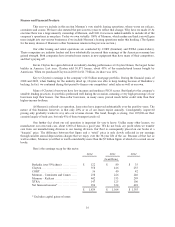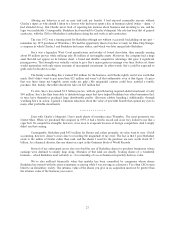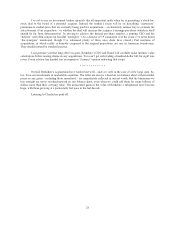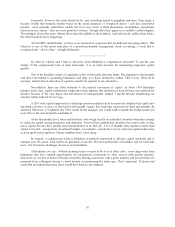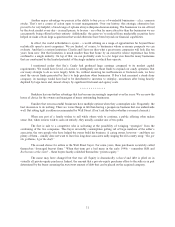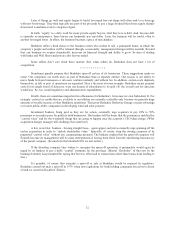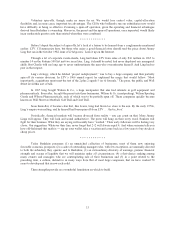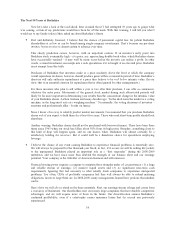Berkshire Hathaway 2014 Annual Report Download - page 27
Download and view the complete annual report
Please find page 27 of the 2014 Berkshire Hathaway annual report below. You can navigate through the pages in the report by either clicking on the pages listed below, or by using the keyword search tool below to find specific information within the annual report.By April 1965, BPL owned 392,633 shares (out of 1,017,547 then outstanding) and at an early-May board
meeting we formally took control of the company. Through Seabury’s and my childish behavior – after all, what
was an eighth of a point to either of us? – he lost his job, and I found myself with more than 25% of BPL’s capital
invested in a terrible business about which I knew very little. I became the dog who caught the car.
Because of Berkshire’s operating losses and share repurchases, its net worth at the end of fiscal 1964 had
fallen to $22 million from $55 million at the time of the 1955 merger. The full $22 million was required by the
textile operation: The company had no excess cash and owed its bank $2.5 million. (Berkshire’s 1964 annual report
is reproduced on pages 130-142.)
For a time I got lucky: Berkshire immediately enjoyed two years of good operating conditions. Better yet,
its earnings in those years were free of income tax because it possessed a large loss carry-forward that had arisen
from the disastrous results in earlier years.
Then the honeymoon ended. During the 18 years following 1966, we struggled unremittingly with the
textile business, all to no avail. But stubbornness – stupidity? – has its limits. In 1985, I finally threw in the towel
and closed the operation.
************
Undeterred by my first mistake of committing much of BPL’s resources to a dying business, I quickly
compounded the error. Indeed, my second blunder was far more serious than the first, eventually becoming the most
costly in my career.
Early in 1967, I had Berkshire pay $8.6 million to buy National Indemnity Company (“NICO”), a small but
promising Omaha-based insurer. (A tiny sister company was also included in the deal.) Insurance was in my sweet
spot: I understood and liked the industry.
Jack Ringwalt, the owner of NICO, was a long-time friend who wanted to sell to me – me, personally. In
no way was his offer intended for Berkshire. So why did I purchase NICO for Berkshire rather than for BPL? I’ve
had 48 years to think about that question, and I’ve yet to come up with a good answer. I simply made a colossal
mistake.
If BPL had been the purchaser, my partners and I would have owned 100% of a fine business, destined to
form the base for building the company Berkshire has become. Moreover, our growth would not have been impeded
for nearly two decades by the unproductive funds imprisoned in the textile operation. Finally, our subsequent
acquisitions would have been owned in their entirety by my partners and me rather than being 39%-owned by the
legacy shareholders of Berkshire, to whom we had no obligation. Despite these facts staring me in the face, I opted
to marry 100% of an excellent business (NICO) to a 61%-owned terrible business (Berkshire Hathaway), a decision
that eventually diverted $100 billion or so from BPL partners to a collection of strangers.
************
One more confession and then I’ll go on to more pleasant topics: Can you believe that in 1975 I bought
Waumbec Mills, another New England textile company? Of course, the purchase price was a “bargain” based on the
assets we received and the projected synergies with Berkshire’s existing textile business. Nevertheless – surprise,
surprise – Waumbec was a disaster, with the mill having to be closed down not many years later.
And now some good news: The northern textile industry is finally extinct. You need no longer panic if you
hear that I’ve been spotted wandering around New England.
25



